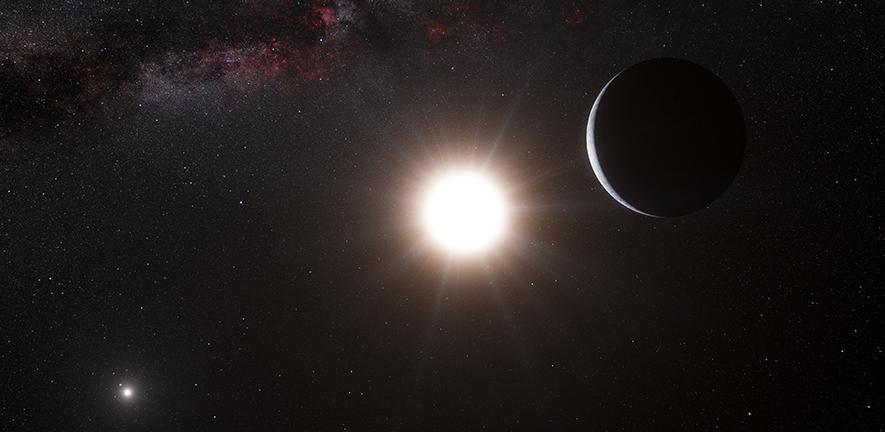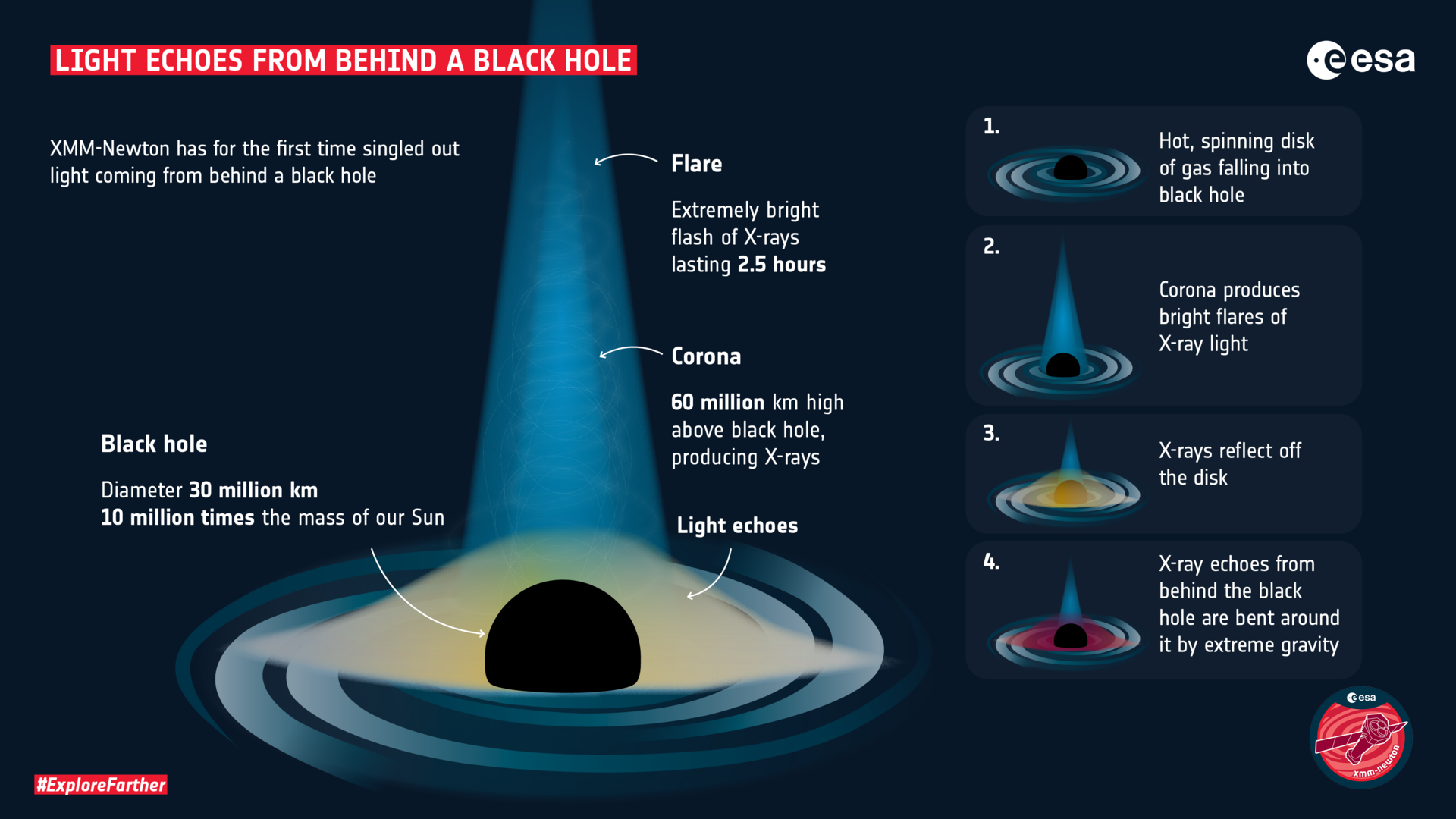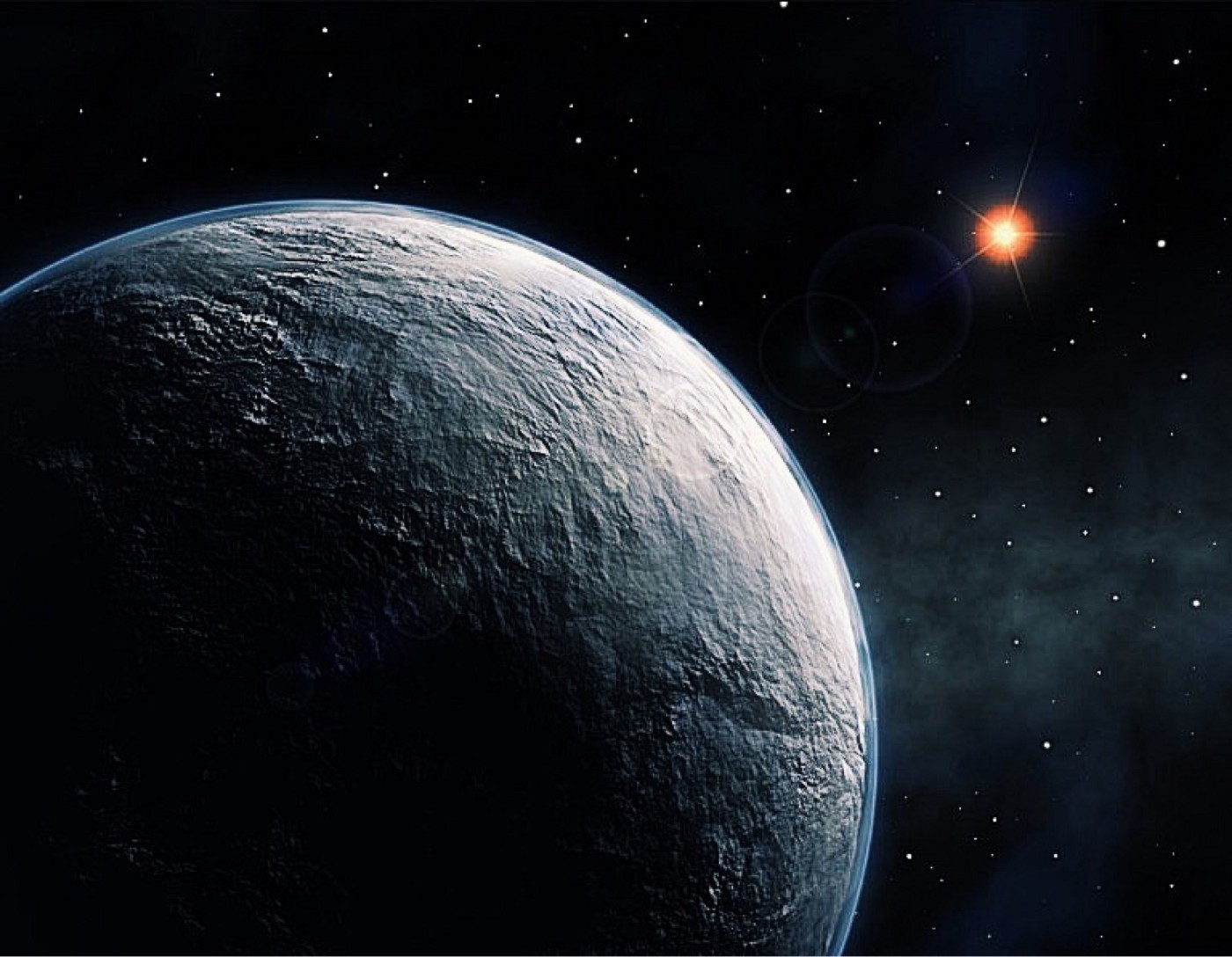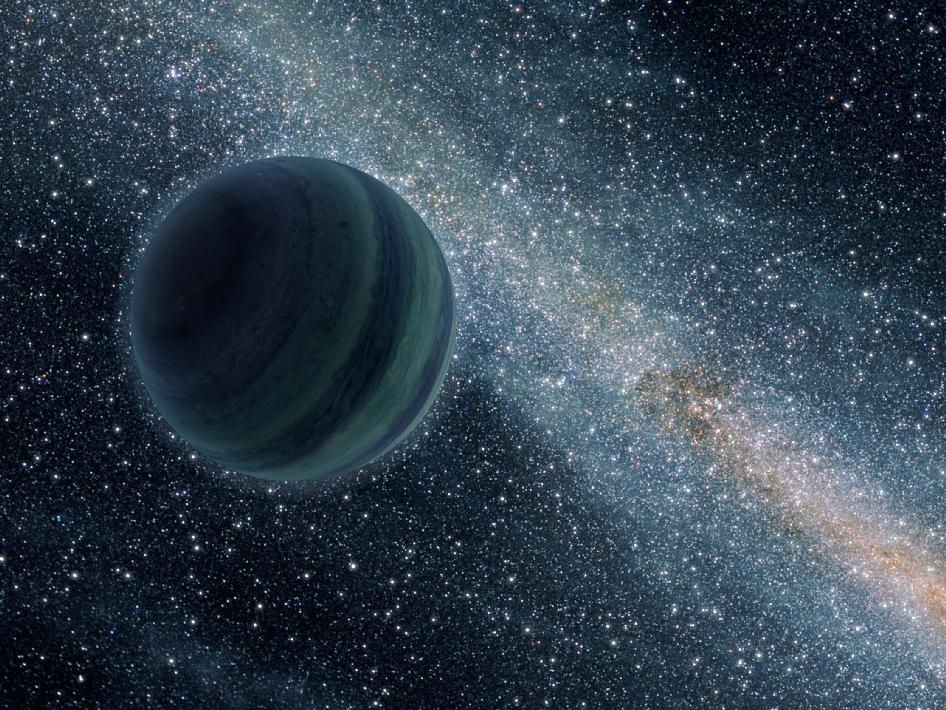Once again, science has proved Einstein’s theories correct. This time, observations taken with ESA’s XMM-Newton and NASA’s NuSTAR space telescopes have seen x-ray flashes bent from behind a black hole. Plus, so many exoplanet stories (Beth was left in charge) and this week’s What’s Up.
Podcast
Transcript
Hello and welcome to the Daily Space. I am your host Beth Johnson, and I am here to put science in your brain.
By this point, some of you may have heard that there was an 8.2 magnitude earthquake off the Aleutian Islands of Alaska last night. While there was a tsunami warning issued, the resulting waves only reached about a foot in height. This was the largest U.S. earthquake in 50 years, and aftershocks are still being recorded with the largest so far occurring four minutes after the main quake at a magnitude of 6.1. No accounts of damage to buildings or injuries to people have been reported, which is great. I have seen someone’s video from their boat that captured landslides in the hills surrounding the marina, but that seems to be about all. If you are in the region, please stay safe.
And now for the news.
First up, we have a new entry to our BABIES award list: the COol Companions ON Ultrawide orbiTS or COCONUTS survey out of the University of Hawai’i. That’s just fantastic really.

And the reason they made it on our radar is that graduate student Zhoujian Zhang has directly imaged an exoplanet, and it’s the closest one to Earth ever directly imaged at a mere 35 light-years away.
The star is called COCONUTS-2, which makes the planet COCONUTS-2b. The star is a low-mass red dwarf, and the planet is a gas giant about six times more massive than Jupiter. The discovery has been published in The Astrophysical Journal Letters and includes that direct image. Now, the planet is a tiny red dot, but that’s okay. It’s there. And as Zhang explains: With a massive planet on a super-wide-separation orbit, and with a very cool central star, COCONUTS-2 represents a very different planetary system than our own solar system.
It’s also the second-coldest planet ever imaged, coming in it at about 175 degrees Celsius. You could not bake cookies on the surface of this planet. Initially discovered in 2011, COCONUTS-2b was thought to be a rogue planet, but now it has a home. We’re excited for Zhang as this work is part of his now-finished doctoral thesis, so congratulations! You’ll be able to take a closer look at Zhang’s image at our website DailySpace.org.
In more exoplanet news, a new paper published in The Astronomical Journal presents an analysis of the atmosphere of one of the first exoplanets ever discovered – Tau Boötis b. This planet was detected using the radial velocity method, which measures the gravitational influence of a planet on its star by studying the wobble of the star.
Tau Boötis b is, like COCONUTS-2b, about six times more massive than Jupiter. It’s also eight times closer to its star than Mercury is to the Sun. That star is only about 51 light-years from us, 40% more massive than the Sun, and one of the brightest stars known to have planets. Using the SPIRou instrument at the Canada-France-Hawaii Telescope, scientists gathered spectrographic data in infrared wavelengths over the course of 20 hours altogether, measuring the abundances of any molecule that contained carbon or oxygen. The results were surprising because we make assumptions about other planetary systems based on what we know of our own solar system, and that includes the prevalence of water vapor.

Tau Boötis b should have had a lot of water vapor and a little carbon dioxide, and it just didn’t match the expectations. In fact, it had a lot of carbon dioxide and no water, which gave the team a new mystery to solve — how had this composition happened? Quite possibly, what we consider to be hot Jupiters could actually form farther from their stars at distances similar to our own gas giants, and then migrate in. This means we’ve found yet another challenge to our understanding of planetary formation and evolution. In other words, it’s a Thursday.
Speaking of planetary formation models, new research published in Astronomy & Astrophysics presents the most realistic model of formation for binary star systems. Scientists are working to understand how Tatooine can exist, everyone. Science fiction becomes science fact before our eyes. Sure, we’ve found these systems, so we already knew they’re out there. But how? How did what was surely a chaotic environment for planetary formation manage to work? The researchers looked at the Alpha Centauri system for the answers.

Alpha Centauri is a binary system where a smaller companion star orbits the larger parent star every 100 years or so, and the larger star would act like a mixer, swirling up any dust in the protoplanetary disc. The researchers then used this system as the basis for their model, and they found that the building blocks for planets, or planetesimals, would need to be orbiting the smaller star and start off at least 10 kilometers in diameter. That disc also needs to be pretty circular for the planets to form. After that, the bits all need to move slowly enough relative to each other to stick together instead of breaking apart in collisions. As those baby planetesimals grow larger, they become less prone to being destroyed in collisions caused by the mixing caused by the larger star. So binary systems can have planets simply by growing them rather than capturing rogue planets moving past. This work is an important piece in all that planetary formation theory we keep talking about. More, please!
Stepping away from the land of exoplanets, I am now going to attempt to explain why Einstein was right. I would like to note that Einstein is usually right. But I generally leave the astrophysics to Pamela, so I’ll channel her as best I can. Here goes.
One of the biggest theories to come out of Einstein’s work was General Relativity, which basically deals with objects that are large enough to have a gravitational effect on space-time. Simply put, General Relativity is the theory of gravity.
I want to take a brief moment to remind our audience that a theory is not the same thing as a hypothesis. A hypothesis is that idea you have before you start testing and experimentation, the “maybe because” that sets you on your path. A theory has been proven correct over and over again based on data. Gravity is not going to magically stop working if you don’t believe in it.
Back to Einstein. He published his theory of general relativity back in 1915, and for the last hundred plus years, the astrophysics community has been collecting evidence that backs up that theory. I mean, people have tried to find evidence that disproves General Relativity, and it hasn’t happened. From bending light around the Sun observed during an eclipse in 1919 to this latest story, we keep collecting evidence that supports General Relativity.
And this story proves it in an extreme way. Using ESA’s XMM-Newton and NASA’s NuSTAR space telescopes, researchers observed a spiral galaxy about 800 million light-years away simply named I Zwicky 1. They were looking for information about a corona around the black hole in the galaxy that is a source of bright X-rays. The hypothesis is that the gas that makes up that corona is continuously falling into the black hole and flaring as it is heated. The gas generates magnetic fields, which subsequently are twisted by the massive gravitational effects of the black hole. When the twisting gets to be too much, the magnetic fields snap and release all the built-up energy. The high-energy electrons produce light in X-ray wavelengths.

And here’s where everything gets extremely wild and amazing. The telescopes observed a flare that signified a massive release of energy. Then, per the press release: The X-ray flare observed from I Zwicky 1 was so bright that some of the X-rays shone down onto the disk of gas falling into the black hole. The X-rays that reflected on the gas behind the black hole were bent around the black hole, and these smaller flashes arrived at the telescopes with a delay. These observations match Einstein’s predictions of how gravity bends light around black holes.
Talk about extreme proof. We knew light was bent by massive gravitational fields. Earlier this week, we presented an image that was a cluster of gravitationally lensed galaxies. This really isn’t a theory we question any longer, but to find evidence in this way — seeing reflected light get bent back at us from the backside of a black hole? That’s, well, HUGE.
Even better, since these X-ray echoes have specific wavelengths to them, we can tell by how those wavelengths change, the timing of our observations, and the location they come from in the disk what is happening at the black hole. The team wants to use this method to build a three-dimensional map of the surroundings, which is amazing since black holes are, you know, black. No light. Difficult to map.
This work was published in the journal Nature. And now the team gets to continue studying the corona as originally planned. I love accidental science. Plus, the more I learn about black holes, the more awesome and confusing they are.
In my continuing theme to explore all things exoplanet this week, I want to give a shoutout to Eos magazine for celebrating exoplanets in their August issue. It is packed full of stories, some of which we’re covering here on Daily Space. It’s definitely worth a look at their website to see all the fantastic writing being done, including by Weekly Space Hangout journalists and CosmoQuest-a-Con guests Kimberly Cartier and Morgan Rehnberg.

Earlier this week, I talked about some of the strange atmospheric conditions and possible weather on hot Jupiters – places where the rain is composed of iron, rubies, sapphires, and other materials not usually thought of as liquid molecules. Honestly, I love thinking about fascinating possibilities for exoplanets. These worlds must be a science fiction writer’s dream. You may not be able to host human life on them, but you sure can be creative about other forms of life and their adaptations.
However, the press releases about all these individual worlds might be overshadowing the forest for the trees, so to speak. In a story titled “Exoplanets in the Shadows”, Damond Benningfield takes a look at research areas that are as interesting, if not more so, than all these individual exoplanets we keep reporting on.
First up, necroplanetology. That’s an awesome name. It’s the study of dead or dying planets, mostly in orbit around white dwarfs, the very hot but no longer fusing cores of stars. Scientists have managed to detect planetary debris orbiting such stars, which were destroyed by the star’s gravity. Taking spectra of these white dwarfs has revealed calcium, magnesium, iron, and other heavier elements. These are all too heavy to remain on the surface of the white dwarf and so would sink into the core over time. To see them in the spectra means they arrived recently as rubble from the planets broken up in the system. This also means that planets can survive as a star goes through expansion during the red giant phase. And we can use this debris to get a glimpse at the inside of planets.
Another area of research involves stars whose brightness slowly changes over time. For example, Boyajian’s Star dimmed and brightened in an unusual pattern, which some people hoped might be a sign of a megastructure around the star and a signal of a technologically advanced alien civilization. More practical hypotheses now involve dust because, of course, dust or maybe even disintegrating exomoons falling in toward the star. And this study gives us another cool new word: necrolunarology.

On top of these two unusual realms of study, scientists are also intrigued by planets orbiting pulsars. These planets have basically been offered a second chance at life. And then there are rogue planets, which are difficult to detect since they’re not orbiting a star and therefore aren’t reflecting a star’s light and are also quite cold. The Gaia spacecraft is proving very capable of finding such planets. Plus we need to understand how rogue planets form — do they form independently of a star system the way stars form with a collapse of interstellar dust? Or are they more likely booted from their original star system due to gravitational interactions with other planets or nearby stars?
There is just so much to talk about when it comes to exoplanets as groups and not just individual discoveries. It’s overwhelming and wonderful, and we’ll keep bringing you all the news we can get our hands on. Tomorrow, I’ll look at some more oddball exoplanets.
What’s Up

One of my favorite objects in the night sky is Orion, but here in the northern hemisphere, it’s primarily a winter constellation. I have definitely spent a few chilly nights at a telescope checking out all the wonders of Orion.
After all, Orion has a recognizable pattern of stars, from the bright shoulders of Betelguese (explode, please) and Bellatrix to the distinct three stars of Orion’s belt, made up of Mintaka, Alnilam, and Alnitak. Down at Orion’s foot is Rigel, another bright, easy-to-find star which is a blue supergiant. And within Orion is the Orion Nebula or Messier 42. This object is a star-forming region that has inspired many an astrophotographer to set up their gear and image the night away. You can make it out with the unaided eye as a dark blur on the night sky.
Also found in Orion is the famous Horsehead Nebula, IC 434, another favorite of observers. This will require at least a small telescope, as will several other smaller nebulae and stars. If you want to see Barnard’s Loop or the Flame Nebula, you’ll need a larger telescope. But, more to the point, Orion has been missing from our night sky but is starting to rise late at night in the east. He’s reclined on his side, and as the summer progresses, he’ll be up earlier and earlier in the night. And what a welcome sight he is.
However, it’s still summer, so if you keep looking overhead, you can still find the Summer Triangle, which Pamela has talked about in previous episodes. Once again, the three bright stars that make up this asterism are Vega, Deneb, and Altair. But it’s a fun challenge to try to pick out a fourth star and create a sort of flattened quadrilateral. This star is Rasalhague, the head of Ophiuchus, another of my favorite constellations. It’s only a 2nd magnitude star, and the trick to finding it is to go about three fist-lengths to the right of Vega and then three fist-lengths up from Altair. We’ll have links to star charts in our show notes so that you can go outside and find this star on your own. Enjoy!
This has been the Daily Space.
Learn More
COCONUTS-2b Directly Imaged by Graduate Student
- University of Hawai’i press release
- “The Second Discovery from the COol Companions ON Ultrawide orbiTS (COCONUTS) Program: A Cold Wide-Orbit Exoplanet around a Young Field M Dwarf at 10.9 pc,” Zhoujian Zhang et al., 2021 July 28, The Astrophysical Journal Letters (preprint on arxiv.org)
Planets Can Form (Very Carefully) in Binary Star Systems
- University of Cambridge press release
- “Planet formation in stellar binaries: Global simulations of planetesimal growth,” K. Silsbee and R. R. Rafikov, to be published in Astronomy & Astrophysics
Tau Boötis b’s Atmosphere Revealed to be Hot and Dry
- CFHT press release
- University of Montreal press release
- “Where Is the Water? Jupiter-like C/H Ratio but Strong H2O Depletion Found on τ Boötis b Using SPIRou,” Stefan Pelletier et al., 2021 July 28, The Astronomical Journal
Light Echo Observed From Backside of a Black Hole
- ESA press release
- “Light bending and X-ray echoes from behind a supermassive black hole,” D. R. Wilkins et al., 2021 July 28, Nature
Exoplanet Research May Be Missing Forest For the Trees
What’s Up: Orion and Rasalhague
- Orion The Hunter Returns Late July Or Early August (EarthSky)
- This Week’s Sky at a Glance, July 23 – 31 (Sky & Telescope)
- Orion – Constellation Guide (freecharts.com)
- Is Ophiuchus A Constellation Or A Sign? (EarthSky)
Credits
Written by Beth Johnson
Hosted by Beth Johnson
Audio and Video Editing by Ally Pelphrey
Content Editing by Beth Johnson
Intro and Outro music by Kevin MacLeod, https://incompetech.com/music/


 We record most shows live, on Twitch. Follow us today to get alerts when we go live.
We record most shows live, on Twitch. Follow us today to get alerts when we go live.